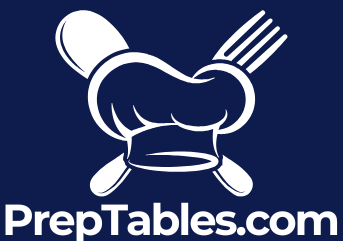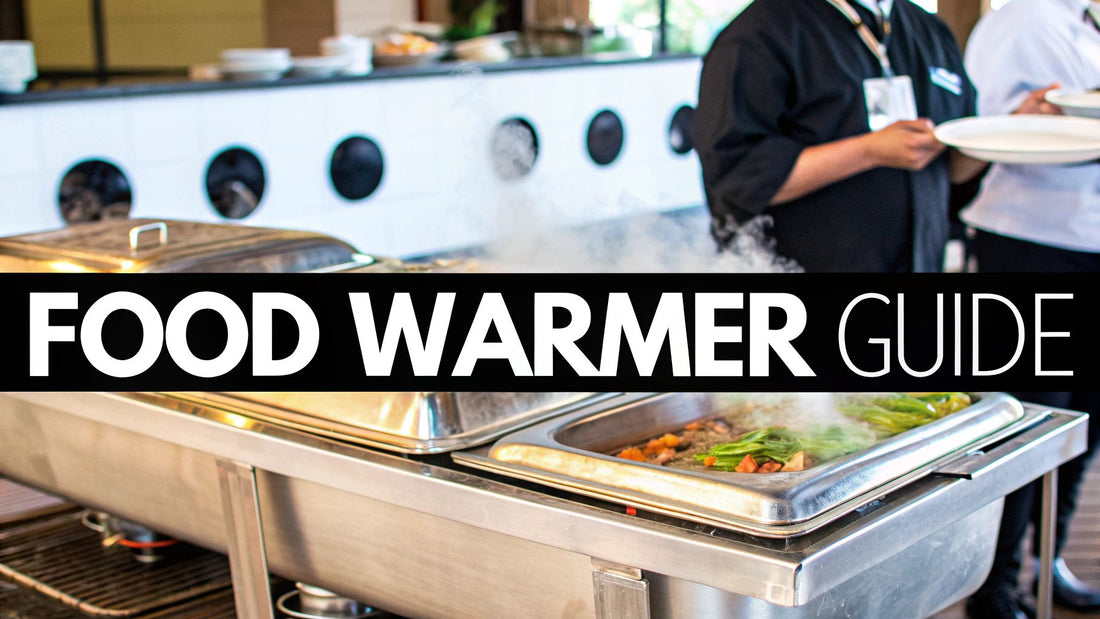
Your Essential Guide to Food Warmer Tables
Share
Think of a food warmer table as the essential link between a perfectly cooked dish and a happy customer. It’s a specialized piece of equipment designed to hold cooked food at a safe, consistent, and delicious temperature right up until the moment it's served. This ensures every plate, whether it's the first one out or the last, keeps its intended quality, texture, and flavor. For any restaurant, buffet, or catering business, this is the unsung hero that bridges the gap between the kitchen's hard work and a flawless dining experience.
Why a Food Warmer Table Is a Kitchen Essential
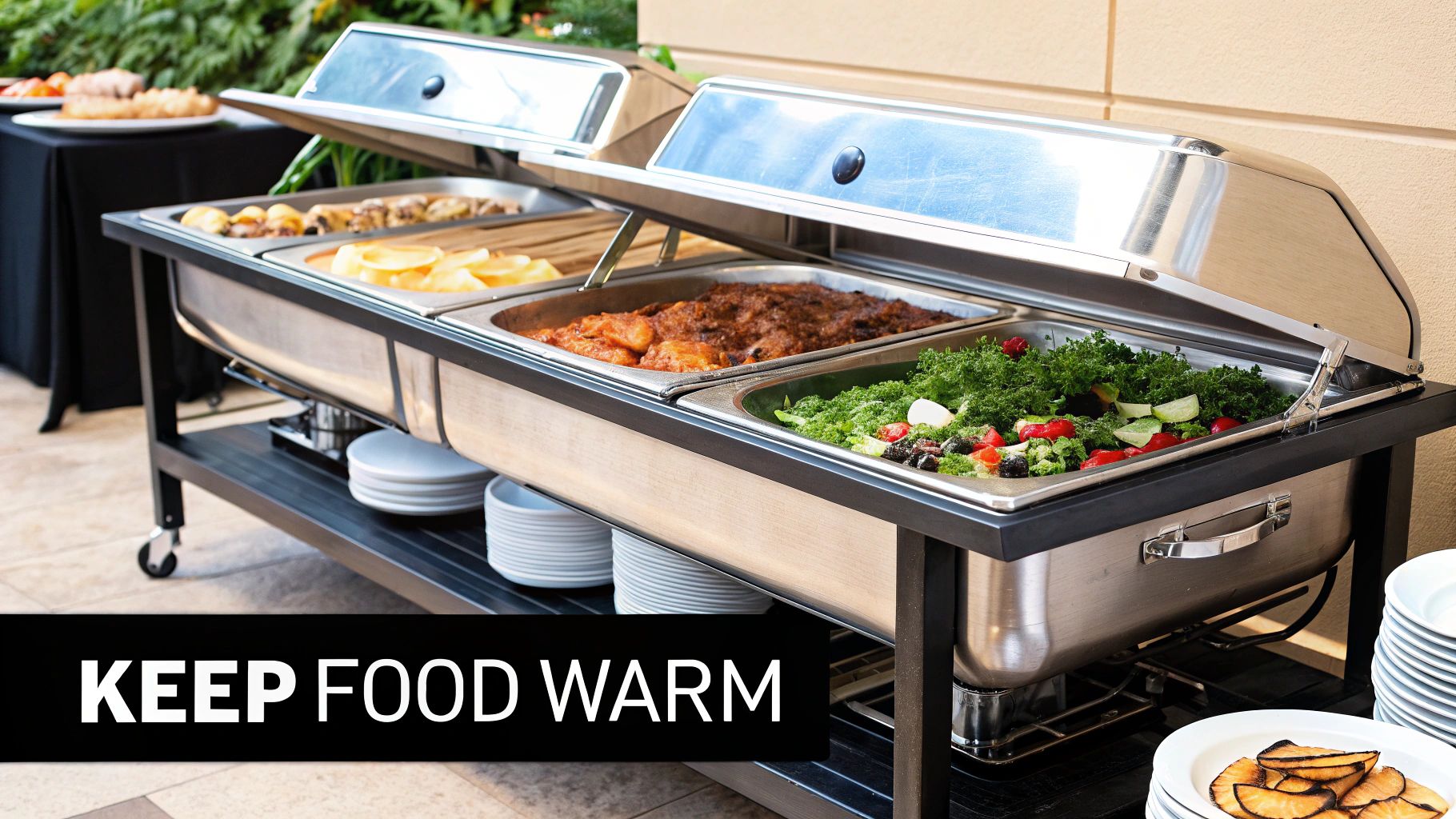
Picture a chaotic dinner service. Your kitchen team is in the zone, plating beautiful dishes one after another. But without the right holding gear, that perfectly seared steak or delicate sauce starts losing heat the second it's ready. Its appeal fades, and worse, it can become a food safety risk. This is precisely where a food warmer table proves its worth, acting like a "culinary holding pattern" that protects the integrity of your menu.
Its main job is simple but absolutely critical: keeping food out of the temperature "danger zone" (40°F to 140°F), where bacteria can flourish. By holding everything at a steady 140°F (60°C) or higher, it protects every meal, helps you stay compliant with health codes, and keeps your customers safe.
The Impact on Kitchen Operations
Beyond just safety, the operational advantages are huge. A food warmer table helps create a much more organized and efficient workflow. Chefs can batch-cook components or even entire dishes during quieter moments, holding them at the perfect temperature for quick assembly when the rush hits. This kind of strategic prep work can slash ticket times and take a ton of pressure off the line cooks.
The result is a service that runs smoother and more predictably, which directly translates to a better customer experience. Guests get their food hot and fresh, just as the chef wanted. That kind of consistency builds a solid reputation for quality, which is what keeps people coming back. It’s no surprise the demand for this equipment is on the rise. The global market for food warmer machines was valued at around USD 2.67 billion and is expected to hit about USD 4.46 billion by 2032, thanks to the boom in food delivery and our fast-paced lives. You can dig deeper into this growing market on Data Bridge Market Research.
Before we move on, let's quickly summarize the biggest wins a food warmer table brings to your kitchen.
Key Benefits of Using a Food Warmer Table
| Benefit | Impact on Your Operations |
|---|---|
| Enhanced Food Safety | Keeps food above the 140°F "danger zone," preventing bacterial growth and ensuring health code compliance. |
| Improved Food Quality | Maintains ideal temperature, preserving the taste, texture, and moisture of dishes until they are served. |
| Increased Efficiency | Allows for batch cooking and holding, streamlining workflow and reducing ticket times during peak hours. |
| Reduced Food Waste | Extends the viable serving time of cooked food, minimizing costly waste from unsold or cold items. |
| Greater Consistency | Ensures every customer receives a hot, fresh meal, which builds your reputation for reliability and quality. |
These benefits work together to create a more profitable and less stressful kitchen environment.
Reducing Waste and Maximizing Profit
Finally, let’s talk money. A food warmer table is a powerful tool for controlling costs. In any busy kitchen, it's easy to misjudge demand, leading to extra food that gets cold, becomes unsellable, and ends up in the trash. By extending the serving life of your dishes without dropping the quality, these tables drastically reduce food waste.
A food warmer table doesn’t just keep food hot; it protects your product, streamlines your service, and preserves your profits. It’s an investment in consistency and quality control.
Every dish you save from the bin is money that goes straight back to your bottom line. For any commercial kitchen—from a neighborhood bistro to a massive catering operation—a food warmer table isn't a luxury. It's a fundamental piece of the puzzle for a successful, profitable business.
Navigating the Different Types of Food Warmers
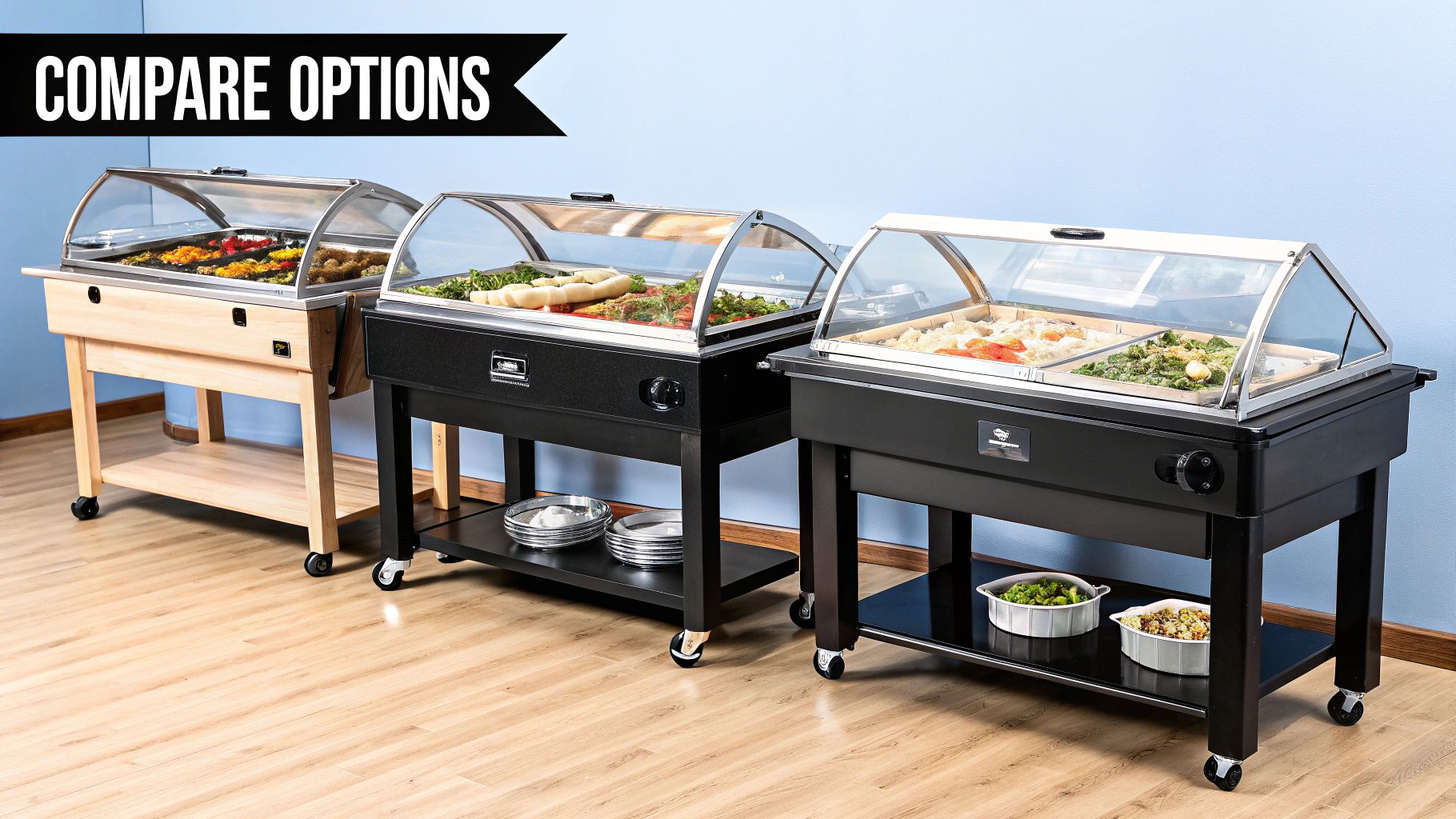
When you start digging into commercial kitchen equipment, you quickly learn that not all warming units are created equal. A food warmer table isn't some one-size-fits-all solution; the right one for you comes down to your menu, how you serve, and your day-to-day operations. Getting a handle on the main differences is the first step to setting up a killer service line.
The most classic setup, and the one most people recognize, is the steam table, sometimes called a bain-marie. Think of it as a gentle sauna for your food. These units use a big reservoir of hot water to create steam, which then evenly and gently warms the food pans sitting just above it.
This kind of moist heat is absolutely perfect for anything that might dry out. It’s the secret to keeping mashed potatoes creamy, gravies and sauces perfectly liquid, and making sure dishes like mac and cheese stay luscious and tempting for hours on end.
Dry Well Warmers for Crispy Perfection
On the flip side, you have dry well warmers. Unlike their steamy cousins, these units use exposed heating elements that radiate heat right up to the food pans. This gives you a much more intense, dry heat, making it the only real choice for anything you need to keep crispy.
Picture serving up beautiful, golden fried chicken that’s turned soggy in a steam table—it’s a total letdown. A dry well food warmer table is built to preserve that satisfying crunch. It’s also the perfect holding spot for things like french fries, onion rings, and other fried appetizers, ensuring they get to the customer with the exact texture you intended.
The core decision between moist and dry heat really just comes down to your menu. If you serve delicate, moisture-rich foods, a steam table is your best friend. If crispy textures are your signature, a dry well warmer is non-negotiable.
Countertop and Mobile Food Warmers
Space and mobility are two other huge factors that will point you toward the right kind of food warmer. For smaller spots with tight kitchen space—think cafes, concession stands, or little delis—countertop warmers offer a compact but mighty solution. These smaller units pack the same heating power into a footprint that can squeeze in just about anywhere.
And for businesses that are always on the move, mobile food warmers and insulated holding cabinets are absolute game-changers. These are the workhorses of the catering and event world. Built with sturdy casters and durable frames, they let you haul large amounts of food safely while keeping everything at the perfect temperature, from your kitchen to an off-site venue.
The demand for this kind of flexible equipment is booming. The catering food warmers market was valued at around USD 557.9 million and is expected to hit USD 1,027.7 million by 2035. This trend mirrors the global growth in catering, food delivery, and outdoor events, showing just how critical reliable equipment is in today's dynamic service environment. You can check out the full market analysis on Future Market Insights.
A Quick Comparison of Warmer Types
To make the choice a bit simpler, here’s a quick breakdown of which warmer works best for different foods.
-
Steam Tables (Bain-Maries): The best choice for moist foods.
- Examples: Soups, stews, sauces, mashed potatoes, steamed vegetables.
-
Dry Well Warmers: The go-to for crispy and fried items.
- Examples: Fried chicken, french fries, onion rings, roasted meats.
-
Countertop Warmers: Perfect for small spaces and limited menus.
- Examples: Holding chili for hot dogs, nacho cheese, or a single main dish.
-
Mobile Warmers/Holding Cabinets: Essential for off-site service and transport.
- Examples: Transporting full pans of food for weddings, corporate events, or large parties.
By carefully matching the type of food warmer table to your menu and service style, you can make sure every single dish is served exactly how it was meant to be enjoyed.
Understanding the Variety of Stainless Steel Prep Tables
While a food warmer table holds finished dishes, the journey of every great meal starts on a prep table. In commercial kitchens, stainless steel is the undisputed champion for these work surfaces, and for good reason. It provides a durable, hygienic, and non-reactive foundation for everything from chopping vegetables to assembling complex plates. Understanding the different types available is key to outfitting an efficient kitchen.
Work Tables: The Kitchen All-Rounder
The most common type is the standard stainless steel work table. These are the versatile workhorses found in nearly every commercial kitchen. They typically feature a flat, sturdy top with an undershelf for storage. Their simple, open design makes them suitable for a massive range of tasks, including chopping, mixing, portioning, and plating.
Key features to look for include:
- Undershelves: Most tables come with an adjustable undershelf, which is invaluable for storing equipment, containers, and dry goods, keeping the workspace clear.
- Backsplashes: Many models include a raised lip along the back edge. This simple feature prevents ingredients and liquids from splashing onto walls, simplifying cleanup and improving sanitation.
- Casters: For added flexibility, some tables are fitted with wheels (casters), allowing you to reconfigure your kitchen layout as needed.
Specialized Prep Tables: Built for Efficiency
For high-volume, repetitive tasks, a general-purpose table might not be enough. This is where specialized prep tables, engineered for specific workflows, truly shine. They integrate essential functions into a single, ergonomic station.
Pizza Prep Tables A pizza prep table is the command center of any pizzeria. It combines a large, cool work surface (often marble or granite for easy dough handling) with refrigerated rails on top for holding toppings. Below, refrigerated cabinets provide ample storage for extra dough, sauces, and ingredients. This all-in-one design allows a chef to assemble pizzas quickly and efficiently without moving around the kitchen.
Sandwich and Salad Prep Tables Similarly, sandwich or salad prep tables are designed for speed in delis, cafes, and quick-service restaurants. They feature a cutting board that runs the length of the unit, positioned directly in front of refrigerated wells that hold pans of meats, cheeses, vegetables, and condiments. Everything is kept at a safe temperature and within arm's reach, dramatically speeding up order assembly.
For a deeper dive, our guide on types of stainless steel prep tables covers more options and details.
Decoding Stainless Steel Grades
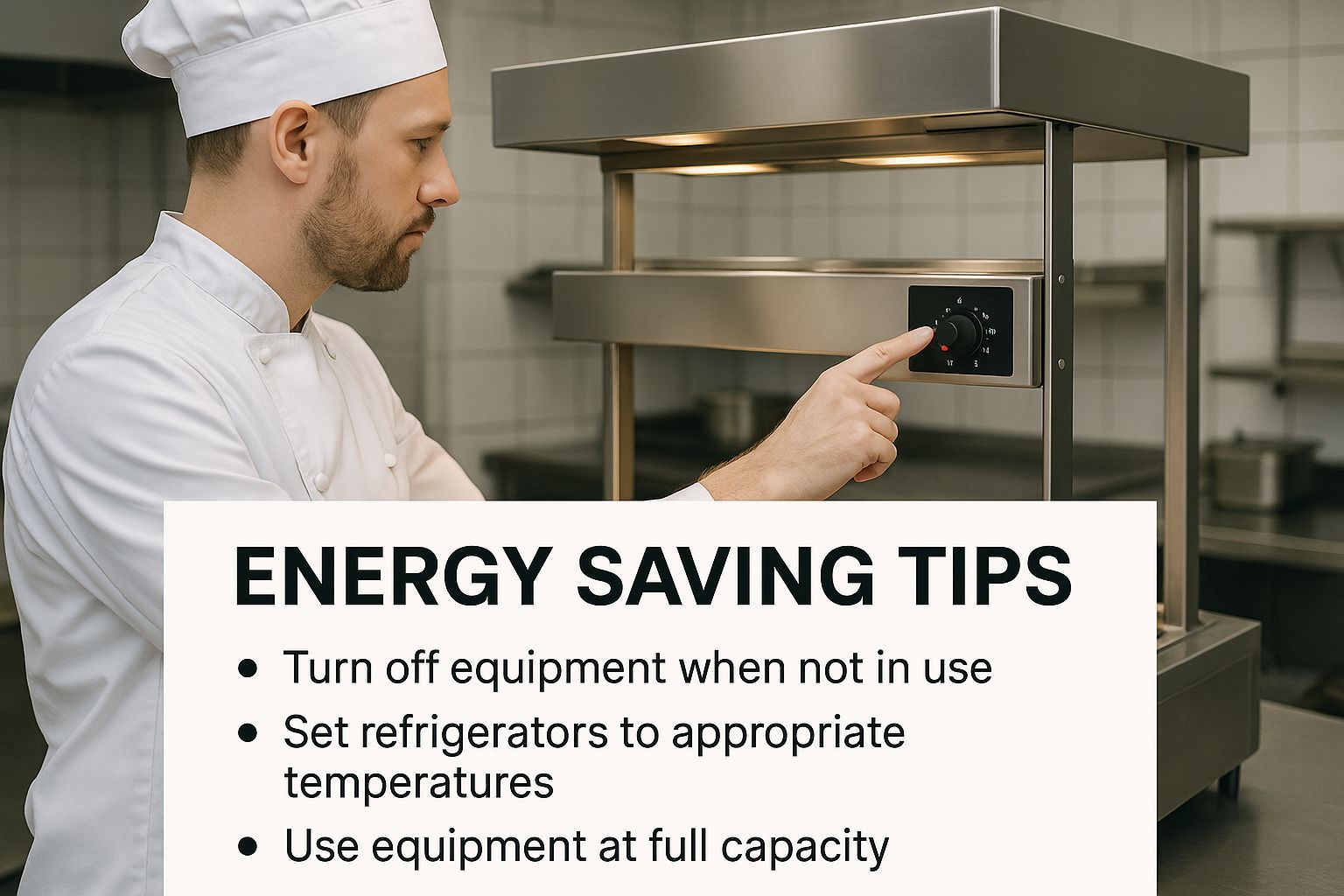
When choosing any stainless steel equipment, you’ll encounter grades like 304 or 430. These numbers indicate the steel’s composition and resistance to corrosion.
- 304 Stainless Steel: This is the industry standard for food-contact surfaces. Its high chromium and nickel content gives it superior resistance to rust and corrosion, making it ideal for tabletops and sinks, especially when acidic foods are involved.
- 430 Stainless Steel: A more budget-friendly option, 430 grade has less nickel, making it slightly more susceptible to corrosion. It is still durable and perfectly suitable for table legs, undershelves, and equipment panels in dry environments.
Choosing the right type and grade of prep table ensures you have a reliable foundation for your kitchen's operations, promoting safety, efficiency, and longevity.
How to Choose the Right Food Warmer Table
Picking the right food warmer table is more than just buying another piece of equipment; it's a real investment in your kitchen's rhythm and efficiency. When you choose wisely from the start, you save yourself a world of trouble later on. Let’s walk through the key things to think about to make sure you land the perfect unit for how you operate.
It all begins with a clear understanding of your menu and service style. Think of it like picking the right tool for a job—you wouldn't grab a sledgehammer to do fine woodworking. In the same way, the food warmer table you choose has to match the kind of food you serve and the volume you push out every day.
Assessing Your Capacity and Space
The first question you’ve got to ask is about capacity. How many food pans do you really need to hold at once when you're in the middle of a rush? A small coffee shop might get by with a two-pan countertop unit, but a big buffet operation will need a full-sized table that can handle six or more full-size pans. Just tally up the main menu items that need to be held to get a solid number.
Next up, grab a tape measure and figure out your physical footprint. Kitchen space is prime real estate, and a unit that’s too big can throw your whole workflow out of whack. Carefully measure the spot where it will go, making sure there's enough room for staff to move around it without bumping into each other. You also need to account for proper ventilation, which is especially important for gas models. Don't forget to look up and consider vertical space if you're eyeing a unit with overhead shelves.
Your choice should be a balance between maximum capacity and efficient use of space. A table that's too small creates bottlenecks, while one that's too big is an inefficient use of both capital and kitchen real estate.
Power Source and Heat Type
Your next big decision comes down to the power source. Electric models are definitely the most common, offering a simple plug-and-play setup and really consistent heating. Gas units, which run on natural gas or propane, tend to heat up faster and can be cheaper to run in places with high electricity costs. Just remember, they require a professional for installation and need proper ventilation.
It’s just as important to decide between moist and dry heat. As we've covered, steam tables are perfect for keeping delicate foods like sauces, veggies, and pastas happy. On the other hand, dry well warmers are a must if you want to keep that perfect crispy texture on fried items. Make a quick checklist of your menu to figure out which type of heat will serve you best.
Exploring Advanced Features
Today’s food warmer tables come loaded with features that can make your life a lot easier. Look for models that have individual temperature controls for each well. This is a game-changer, letting you hold different dishes at their own unique, perfect temperatures all at the same time.
Digital displays are another great feature, giving you precise temperature readings at a glance. This takes the guesswork out of the equation and is a big plus for food safety. Also, with energy costs always on the rise, investing in an energy-efficient design can lead to some serious long-term savings. This focus on efficiency is a big reason why the global market for heated shelf food warmers, valued at about USD 4,904.7 million, is expected to hit USD 7,401 million by 2035. You can dig into what's behind this growth by checking out the latest industry insights.
By carefully thinking through these factors—capacity, space, power, and features—you can confidently pick a food warmer table that fits your budget and seriously elevates your service. For a wider look at choosing different kitchen stations, take a look at our complete prep tables buying guide to help you make smart decisions for your whole kitchen.
Taking Care of Your Food Warmer Table
Your food warmer table is a true workhorse, and just like any essential piece of kitchen equipment, it needs regular care to keep it running smoothly. Good maintenance isn't just about extending the life of your unit—it’s absolutely critical for food safety and keeping your service line efficient. A simple but consistent routine can save you from expensive repairs down the road, keep your setup looking professional, and protect your investment.
Good maintenance actually starts with proper installation. Before you even plug it in, make sure your kitchen's electrical setup can handle the load. Commercial food warmers often need a dedicated circuit to stop breakers from tripping in the middle of a busy dinner rush. You'll also want to leave enough space around the unit for air to circulate, which keeps it from overheating and protects its internal parts.
Daily Cleaning Is a Must
Cleaning your warmer every day is non-negotiable. At the end of each shift, pull out all the food pans and inserts and give them a thorough wash. The wells of the warmer—whether it's a steam table or a dry one—have to be wiped down to get rid of any spills or bits of food.
This simple habit is your best defense against bacteria and cross-contamination. All you need is a soft cloth or sponge with a mild, food-safe detergent and warm water. If you have a steam table, remember to drain the water from the well before cleaning to keep mineral scale from building up.
A clean food warmer table says a lot about your kitchen's standards. It's not just about looks; it's a direct reflection of your commitment to food safety. Daily cleaning is the single most important thing you can do.
Going Deeper: Periodic Checks and Cleaning
Beyond the daily wipe-down, you'll want to schedule some deeper maintenance to keep your table in top shape for the long haul. This means more thorough cleanings and quick inspections of the important parts.
- Descaling Steam Tables: If your area has hard water, you'll eventually see a chalky buildup called limescale inside the wells of your steam table. This stuff acts like an insulator, making the heating element work way harder and less efficiently. Every few months, use a commercial descaling solution to clear it out, making sure to follow the manufacturer's directions.
- Checking Heating Elements: For dry well warmers, take a look at the heating elements every so often. Check for any damage or gunk built up on them. Keeping them clean ensures the heat spreads out evenly.
- Thermostat Calibration: Every now and then, use a reliable food thermometer to check if your thermostat is accurate. If the temperature you set is way off from the actual temperature, it might be time for a professional to recalibrate or repair it. An off-kilter thermostat can easily put your food in the "danger zone," which is a serious safety risk.
Keeping Your Stainless Steel Looking Sharp
Finally, a little care for the stainless steel exterior will keep your food warmer table looking like new. Always wipe in the direction of the grain to avoid tiny scratches. Stay away from abrasive scrubbers like steel wool or harsh chemicals like bleach, as they can ruin the protective surface of the steel and lead to rust.
For tough spots or just to bring back that shine, a good stainless steel cleaner can work wonders. It’ll make sure your equipment remains a point of pride in your kitchen.
Frequently Asked Questions
When it comes to food warmer tables, a few questions pop up time and time again. Getting these right is about more than just convenience—it’s about safety, quality, and making sure your equipment lasts. Let's tackle some of the most common things people ask.
What Is the Ideal Temperature for a Food Warmer?
If there's one number to remember in food service, it's this one. The ideal holding temperature for a food warmer table is 140°F (60°C) or higher. This isn't just a friendly suggestion; it's the golden rule for food safety.
Think of anything between 40°F and 140°F as the "danger zone." In this range, bacteria can have a field day and multiply like crazy. Letting food sit below 140°F is asking for trouble. That’s why you absolutely must check the internal temperature of your food regularly with a good thermometer. It's a non-negotiable step for keeping food safe and delicious.
Can You Cook Food in a Food Warmer Table?
This is a huge misconception, and a dangerous one at that. A food warmer table is only for holding food that's already been cooked. It is not, under any circumstances, designed to cook raw food from scratch. The heating elements just aren't powerful enough to get raw ingredients up to a safe temperature quickly.
Attempting to cook in a food warmer is a significant food safety hazard. The slow heating process would leave food lingering in the temperature danger zone for far too long, creating a perfect breeding ground for harmful bacteria.
Always cook your food thoroughly first using the right gear, like ovens or griddles. Once it hits a safe internal temperature, then you can move it over to the warmer to keep it hot for service.
How Often Should I Clean My Prep Tables and Warmers?
A clean kitchen is a safe kitchen, and regular cleaning also keeps your stainless steel equipment in top shape for years. A simple, consistent cleaning routine is your best friend here.
Here’s a good schedule to follow:
- Between Tasks: Always wipe down and sanitize your surfaces when you switch from one food to another. This is especially critical when going from raw ingredients to ready-to-eat foods.
- End of Day: Give everything a deep clean at the end of each shift. Pull out all the food pans, wash them properly, and then clean out the wells and surfaces of the warmer and any prep tables. Make sure to use a food-safe cleaner that isn't abrasive.
Stay away from harsh chemicals or scrubbers like steel wool. They can scratch the protective layer on your stainless steel, which can lead to rust down the road. A soft cloth and the right cleaner are all you need to protect your investment.
For a complete range of professional-grade stainless steel tables and food service equipment, visit PrepTables.com. Find the durable, NSF-certified solutions you need to optimize your kitchen's workflow and safety standards at https://preptables.com.
